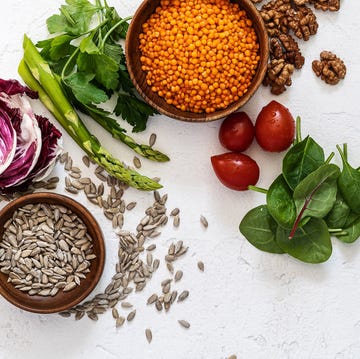What do you think when you hear the word fibre? Stodge? Bland cereals the texture of cardboard? Digestive, er… regularity?
Perhaps you just don’t think of it much at all. If so, you’re not alone. While NHS guidelines suggest adults should eat around 30g of dietary fibre each day, a survey conducted by General Mills suggested that only one in 10 of us is doing so.
Unless, that is, you’re a fan of #WellnessTok. On TikTok, videos praising the myriad health benefits of fibre are proliferating. It’s crucial for gut health and even lowers your risk of developing some of the most common diseases – and, ultimately, causes of death – in the UK. One landmark study, published in 2019, suggested that diets rich in fibre can reduce your risk of heart disease, stroke, type 2 diabetes and colon cancer by between 16 and 24%, and another study links low-fibre intake to colon cancer. Plus, it can be particularly helpful to women as we age.
What to read next
So, should we, in the words of TikTokers, start fibremaxxing?
Heart disease
Fibre is essentially just a form of carbohydrate that your body can’t break down, so once eaten, it passes through the body undigested. There are two forms. As its name suggests, insoluble fibre doesn’t dissolve in water. It’s the type found in wholegrains and wheat cereals, as well as some vegetables (carrots, celery and tomatoes).
Soluble fibre, on the other hand, dissolves in water and turns into a gel-like substance in your gut. Sources include barley, oatmeal, beans, nuts and fruits such as apples, berries, citrus fruits and pears. Both types have been linked to heart health. In fact, one study found that increasing your dietary fibre intake by just 10g a day is associated with a 17% reduction in coronary heart disease mortality.
Dietitian Dr Carrie Ruxton, working with General Mill on their campaign to get us eating more fibre, says: ‘Eating more fibre is a natural way to help lower blood cholesterol. Studies show that beta-glucan, a specific fibre found in rye, barley and oats, can lower “bad” LDL cholesterol by 5-10%.’
Diabetes
‘High-fibre diets help to slow down the absorption of sugars in the gut, which helps people with blood glucose control,’ explains GP Dr Gill Jenkins. ‘Soluble fibres, from oats, fruit and vegetables, are the best sources for supporting diabetes prevention.’
In fact, large-scale studies show that eating more fibre (over 25g a day for women, and 38g per day for men) can reduce your risk of developing type 2 diabetes by 20–30%.
Cancer
A recent study, published in the journal Nature Microbiology, found that diets low in fibre could heighten the risk of bowel cancer, a disease that is surging among young people across developed countries worldwide.
Why? ‘Fibre protects the bowel by promoting beneficial bacteria and speeding up gut transit times, so toxins have less of a chance to harm the bowel lining,’ says Dr Ruxton.
Some studies have also found a correlation between fibre and breast cancer. In 2020, a Harvard University analysis – published in the journal, Cancer, and pooling data from 20 previous studies that took in a collective 2m women – suggested that those who eat the most fibre are less likely to develop the disease. This may be because higher fibre diets are associated with lower oestrogen levels.
Obesity
A study published last year in the Journal of Nutrition found that a specific type of dietary fibre found in oats, called beta-glucan, acts on the same biochemical pathway as Ozempic, triggering the release of GLP-1, which suppresses appetite. The effects are much milder, of course, but ‘high-fibre diets can help with weight control as they make us feel fuller for longer,’ says Dr Ruxton.
Menopause
According to one 2021 review, women who eat more fibre-packed wholegrains, vegetables and unprocessed foods tend to have less severe menopausal symptoms than those who eat fewer of those foods.
Healthy ageing
Older adults have higher levels of inflammation compared with younger adults. In 2022, a study showed that those who eat more cereal fibre bring their levels down and, with that, their risk of cardiovascular disease, too. ‘With findings from this study, we are now learning that one particular type of dietary fibre – cereal fibre – but not fruit or vegetable fibre was associated with lower inflammation,’ said Rupak Shivakoti PhD, assistant professor of epidemiology at Columbia University Mailman School of Public Health.
3 simple dietary swaps
Sold? There are a few things worth bearing in mind. ‘Fibre is an essential part of any diet, supporting digestion, blood sugar balance, hormone regulation and long-term health,’ says registered and clinically trained nutritional therapist Lucy Miller. ‘However, too much isn’t necessarily a good thing. Going from low to high fibre too quickly can lead to bloating, constipation and may interfere with nutrient absorption in some cases. Like anything in nutrition, it’s about consistency, not extremes. Rather than “fibremaxxing”, I encourage people to build a steady, varied intake through whole foods such as vegetables, berries, pulses, wholegrains, nuts and seeds.’
- Start the day as you mean to go on, suggests Dr Ruxton: ‘Swap your regular breakfast for a high-fibre option. Try Greek yogurt with muesli, nuts, seeds and dried apricots, or bran flakes with banana, or an omelette with red peppers, peas and sliced onions. Starting the day with a fibre boost is also great for avoiding the mid-morning munchies.’
- ‘Make every snack count towards your daily target of 30g of fibre,’ adds Dr Jenkins. ‘Instead of fatty, sugary cakes, biscuits and confectionery, try a handful of almonds, wholegrain toast with peanut butter, carrot sticks with hummus, edamame beans or homemade popcorn.’
- Finally, come supper time: ‘Add a tin of beans or pulses to homemade soups, stews or curries,’ says Dr Ruxton. ‘Ring the changes with butter beans, chickpeas, kidney beans or lentils. Adding a serving of beans boosts the fibre content as well as making your meat dishes go further.’
In other words, says Lucy: ‘It’s not rocket science – just include plenty of fibre in the diet in a natural way, not through processed bars!’













